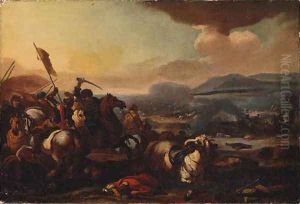Acques (Le Bourguignon) Courtois Paintings
Jacques Courtois, also known as Jacques (le) Bourguignon and later in Italy as Giacomo Cortese, was a notable French painter of the Baroque period, celebrated for his skill in depicting military scenes and battles. Born in Saint-Hippolyte, France, in 1621, into a family with artistic roots—his brother Guillaume Courtois was also a painter—Jacques developed a profound interest in art from a young age. His early life was marked by extensive travel, which greatly influenced his artistic style and preferences. After receiving initial training from his father, a painter and draughtsman, Courtois moved to Italy in his early twenties, which was a common destination for artists seeking to refine their craft through the study of Renaissance and Baroque art.
In Italy, Courtois was profoundly influenced by the work of the great masters, and he quickly gained a reputation for his distinctive approach to battle scenes, combining dynamic composition with meticulous detail and vibrant color. His ability to capture the chaos and fervor of warfare, while maintaining clarity and coherence, set him apart from his contemporaries. Courtois worked in various Italian cities, but his most significant period was in Rome, where he became associated with the circle of artists around Pietro da Cortona.
Courtois's paintings were sought after by patrons across Europe, and he was commissioned to create works for churches, palaces, and private collections. Despite his success, Courtois decided later in life to join the Jesuit Order, around 1655, where he took the name Brother Giacomo Cortese. This decision, however, did not mark the end of his artistic career; he continued to paint, focusing his talents on religious subjects and scenes from the life of the Society of Jesus.
Jacques Courtois died in Rome in 1676. His legacy is preserved in his influential battle scenes, which continue to be admired for their energy, detail, and composition. Courtois's work had a lasting impact on the genre of military painting, influencing subsequent generations of artists in Italy and beyond. Today, his paintings can be found in major museums and collections around the world, testament to the enduring appeal of his dynamic and detailed portrayal of warfare.
